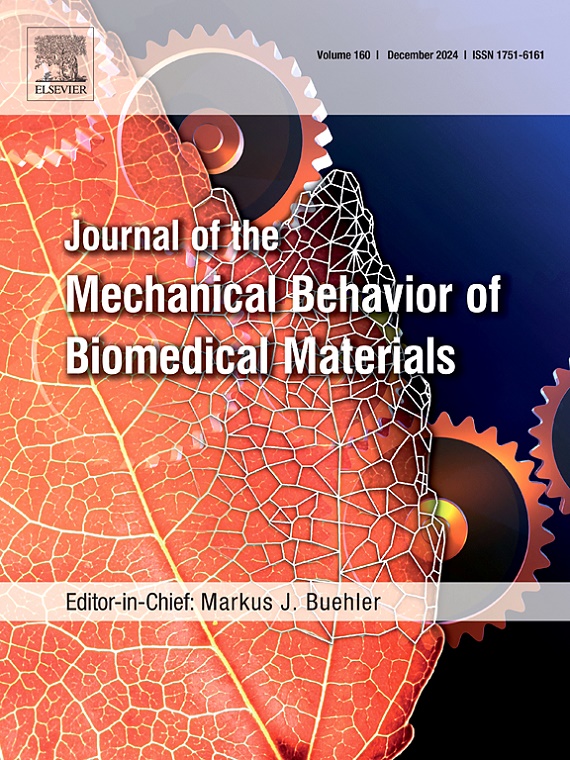实心针插入人体胃组织的实验和数值研究
IF 3.3
2区 医学
Q2 ENGINEERING, BIOMEDICAL
Journal of the Mechanical Behavior of Biomedical Materials
Pub Date : 2024-11-22
DOI:10.1016/j.jmbbm.2024.106832
引用次数: 0
摘要
目的口服给药是给药领域的圣杯。然而,生物利用率低限制了大分子药物的口服。口服装置可以克服这一限制,但在装置与组织相互作用方面还存在知识空白。本研究主要通过实验和数值方法研究针头插入人体胃部的情况。方法用尖针和钝针以 0.0001 和 0.1 米/秒的速度插入切除的人体胃组织。根据拉伸粘弹性生物力学测试确定了构成模型的参数。实验结果表明,0.1 和 0.0001 m/s 时的峰值力分别为 0.995 ± 0.296 N 和 1.281 ± 0.670 N(钝针)以及 0.325 ± 0.235 N 和 0.362 ± 0.119 N(尖针)。针的几何形状对峰值力有明显影响(p < 0.05)。Yeoh-Prony序列组合拟合了拉伸粘弹性生物力学数据,并用于数值模型,拟合效果极佳(R2 = 0.973)。针的几何形状和插入速度都会影响应力轮廓和位移大小以及能量曲线。数值模型与实验数据一致,为早期设备迭代提供了良好的方法。研究结果表明,插入速度和针的形状会影响组织的机械结果。本文章由计算机程序翻译,如有差异,请以英文原文为准。

Experimental and numerical study of solid needle insertions into human stomach tissue
Purpose
Oral drug delivery is the Holy Grail in the field of drug delivery. However, poor bioavailability limits the oral intake of macromolecular drugs. Oral devices may overcome this limitation, but a knowledge gap exists on the device-tissue interaction. This study focuses on needle insertion into the human stomach experimentally and numerically. This will guide early stages of device development.
Methods
Needle insertions were done into excised human gastric tissue with sharp and blunt needles at velocities of 0.0001 and 0.1 m/s. Parameters for constitutive models were determined from tensile visco-hyperelastic biomechanical tests. The computational setup modeled four different needle shape indentations at five velocities from 0.0001 to 5 m/s.
Results
From experiments, peak forces at 0.1 and 0.0001 m/s were 0.995 ± 0.296 N and 1.281 ± 0.670 N (blunt needle) and 0.325 ± 0.235 N and 0.362 ± 0.119 N (sharp needle). The needle geometry significantly influenced peak forces (p < 0.05). A Yeoh-Prony series combination was fitted to the tensile visco-hyperelastic biomechanical data and used for the numerical model with excellent fit (R2 = 0.973). Both needle geometry and insertion velocity influenced the stress contour and displacement magnitudes as well as energy curves.
Conclusion
This study contributes to a better understanding of needle insertion into the stomach wall. The numerical model demonstrated agreement with experimental data providing a good approach to early device iterations. Findings in this study showed that insertion velocity and needle shape affect tissue mechanical outcomes.
求助全文
通过发布文献求助,成功后即可免费获取论文全文。
去求助
来源期刊

Journal of the Mechanical Behavior of Biomedical Materials
工程技术-材料科学:生物材料
CiteScore
7.20
自引率
7.70%
发文量
505
审稿时长
46 days
期刊介绍:
The Journal of the Mechanical Behavior of Biomedical Materials is concerned with the mechanical deformation, damage and failure under applied forces, of biological material (at the tissue, cellular and molecular levels) and of biomaterials, i.e. those materials which are designed to mimic or replace biological materials.
The primary focus of the journal is the synthesis of materials science, biology, and medical and dental science. Reports of fundamental scientific investigations are welcome, as are articles concerned with the practical application of materials in medical devices. Both experimental and theoretical work is of interest; theoretical papers will normally include comparison of predictions with experimental data, though we recognize that this may not always be appropriate. The journal also publishes technical notes concerned with emerging experimental or theoretical techniques, letters to the editor and, by invitation, review articles and papers describing existing techniques for the benefit of an interdisciplinary readership.
 求助内容:
求助内容: 应助结果提醒方式:
应助结果提醒方式:


